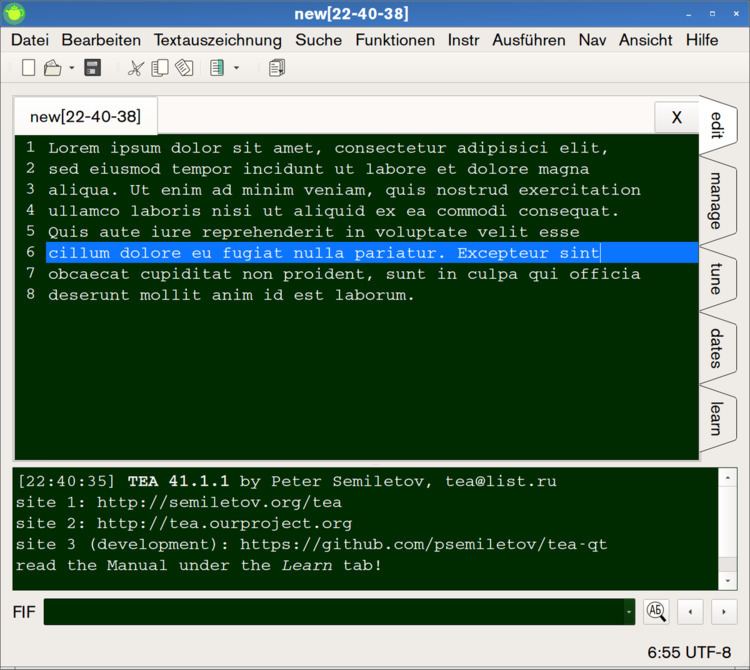Initial release 2001, 15–16 years ago Written in C++ | Stable release 42.0.0 / 5 August 2016 Operating system | |
 | ||
Developer(s) Peter Semiletov (hacker name: Roxton) | ||
TEA is a graphical text editor. Its name is an acronym for Text Editor of the Atomic Era. It is designed for low resource consumption, a wide range of functions and adaptability, and is available for all desktop operating systems supported by Qt 5 or 4.6+, thus also OS/2. Its user interface is localized in several languages.
Contents
UI concept
The functional scope of TEA exceeds that of a pure text editor since it is designed as a desktop environment for text editing. It has five tabs on the right border of the window:
edit represents the actual text editor. On the top of the text editor there is a tab bar for switching between multiple opened text files. The edit tab contains the text editing window. Below that window there is another window which displays the editing history and below the history there is the FIF, the "Famous Input Field" follows. The FIF is a special command line for entering TEA-specific commands. The editing history and the FIF are also visible in the four other tabs.
The tab manage contains a file manager for navigating in the computers file system opening files.
tune is a settings tab, for changing the behavior of TEA and modifying the content of the menu bar.
dates contains a calendar.
The tab learn contains a detailed user manual including instructions for the FIF.
Features
FIF
The Famous Input Field is a TEA specific command line. In order to find an replace text, enter e.g. SOURCETEXT~TARGETTEXT and click on Replace, Replace All or Replace all in opened files in the Search menu. The string SOURCETEXT well be replaced by the string TARGETTEXT in the chosen way.
In addition, the FIF includes three separate search buttons, located on the right side.
Plugin system
TEA contains also a plugin system. On the TEA website there available e.g. a plugin called Acalc, which supports all JavaScript.Math functions (sin, cos, sqrt etc.). E.g. by entering a formula like 2+2*sqrt(13) in the text editor, selecting it and clicking onto Acalc in the plugin menu, the formula will be solved.
History
Originally TEA was a program for Windows. In version 1.0.0.49, released on 30 December 2001, it is evident that the acronym TEA then still meant Text Editing and Authoring. Later on a version for Linux using GTK + was written, which made it possible to compile the program for both Windows and Linux. TEA is one of those programs that were later on rewritten using Qt (cf. e.g. the media player VLC).
The program and the website were initially available only in Russian, which has had a negative impact on the popularity and reach outside of Ukraine and Russia. Meanwhile, the website is bilingual (Russian and English) and the program itself has been localized in several languages.
Website history:
